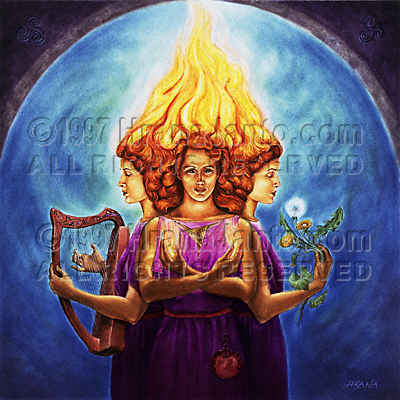 |
|
|||||
PREVIOUS | NEXT | A,B,C, D,E, F,G,H,I, J,K,L,M, N,O,P,Q, R,S, T,U,V,W,X,Y,Z | Help | ALL | INDEX
| Brigid from Goddesses and Heroines |
Exerpt from Goddess & Heroines by Patricia
Monaghan [Used by permission. This text is NOT included in the Goddess Oracle] |
Probably the clearest example of the survival of an early goddess into Christian times is Brigid (pronounced "breed"), the great triple goddess of the Celtic Irish who appeared as Brigantia in England, Bride in Scotland, and Brigandu in Celtic France.
So entrenched was the devotion of the Irish to their goddess that the Christians "converted" her along with her people, calling her Bridget, the human daughter of a Druid, and claiming she was baptized by the great patriarch St. Patrick himself. Bridget took religious vows, the story went on, and was canonized after her death by her adoptive church, which then allowed the saint a curious list of attributes, coincidentally identical to those of the earlier goddess.
The Christian Bridget, for instance, was said to have had the power to appoint the bishops of her area, a strange role for an abbess, made stranger by her requirement that her bishops also be practicing goldsmiths. The ancient Brigid, however, was in one of her three forms the goddess of smithcraft. Brigid also ruled poetry and inspiration, carrying for this purpose a famous caldron; her third identity was as a goddess of healing and medicine. Not surprisingly, the Christian Bridget was invoked both as a muse and as a healer, continuing the traditions of the goddess.
There were three Brigids, who were probably never construed as separate goddesses but as aspects of one divinity; unlike other triple goddesses, they were identical, not aging through the typical maiden-mother-crone sequence. The Brigids were unified in the symbol of fire, for her name means "bright arrow," or simply the "bright one." Almost into modern times, the ancient worship of the fire goddess Brigid continued at her sacred shrine in Kildare, where 19 virgins tended the undying fire and where, on the 20th day of each cycle, the fire was miraculously tended by Brigid herself. There, into the 18th century, the ancient song was sung to her: "Brigid, excellent woman, sudden flame, may the bright fiery sun take us to the lasting kingdom." But for more than 10 centuries, the Bridget invoked was a saint rather than a goddess; her attendants, nuns rather than priestesses.
The Irish said that the goddess Brigid brought to humanity a num ber of useful things, including whistling, which she invented one night when she wanted to call her friends. And when her beloved son was killed, Brigid invented keening, the mournful song of the bereaved Irishwoman; this story draws her close to the great mother goddesses of the eastern Mediterranean, and like them, Brigid was identified with the earth herself and with the soil's fertility.
Ritual, that most conservative of forces, preserved Brigid's name and symbols for more than 1,000 years after she ceased to be acknowledged as a goddess. But little is left of the legends told of one of the greatest of all Celtic goddesses, a deity so high that her brass shoe was the most sacred object that could be imagined, a divinity so intensely related to the feminine force that no man was allowed to pass beyond the hedge surrounding her sanctuary.
Some rituals and legends suggest that Brigid's history may date back even
beyond the era of the Celts-that she may have taken on some of the aspects of
an even more ancient seasonal goddess of the pre-Celtic inhabitants of Ireland
and Scotland. In the latter, a series of stories relate how the Cailleach kept
a maiden named Bride imprisoned in the high mountains of Ben Nevis. But her
own son fell in love with the girl and, at winter's end, he eloped with her.
The hag chased them across the landscape, causing fierce storms as she went,
but finally she turned to stone and Bride was freed. In such stories, which
may date back as much as 2000-3000 years, Brigid becomes a surrogate for a spring/summer
goddess whose rule over the land alternated with that of a fall/winter hag.
Similarly, the fact that the massive sandstones called sarsens, used in the
building of such ancient pre-Celtic monuments as Stonehenge and Avebury, are
called Bridestones, suggests that Brigid's identity as a primary goddess caused
her name to be used of Neolithic (late Stone Age) divinities of the area.
| Back to TOP | Published by Llewellyn, copyright 1997. Used by permission of the author. |
![]()